Around the World
July/August 2022


-
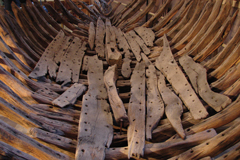 MASSACHUSETTS: Timbers from a ship known as Sparrow-Hawk may belong to the oldest known shipwreck in English colonial America. In 1626, the Plimoth Colony governor William Bradford recorded that an unnamed ship carrying 2 English tobacco merchants and their Irish servants ran aground off Cape Cod. The wreck’s survivors were rescued by Native Americans and brought to the fledgling colony. Recent dating revealed that sections of Sparrow-Hawk’s hull were made from trees felled in England between 1556 and 1646, further evidence that this was the ship that made the ill-fated voyage.
MASSACHUSETTS: Timbers from a ship known as Sparrow-Hawk may belong to the oldest known shipwreck in English colonial America. In 1626, the Plimoth Colony governor William Bradford recorded that an unnamed ship carrying 2 English tobacco merchants and their Irish servants ran aground off Cape Cod. The wreck’s survivors were rescued by Native Americans and brought to the fledgling colony. Recent dating revealed that sections of Sparrow-Hawk’s hull were made from trees felled in England between 1556 and 1646, further evidence that this was the ship that made the ill-fated voyage. -
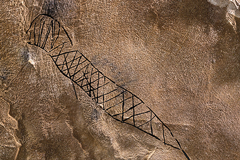 ALABAMA: The 19th Unnamed Cave contains the greatest concentration of Native American cave art in the Southeast. Hundreds of human and animal glyphs were traced into mud covering the walls more than 1,000 years ago. Recent high-resolution 3-D modeling revealed 5 gigantic images on the cavern’s ceiling that researchers were previously unable to see. Among the images is a 10-foot-long serpent, likely a diamondback rattlesnake, that is believed to be the largest cave art figure ever found in North America.
ALABAMA: The 19th Unnamed Cave contains the greatest concentration of Native American cave art in the Southeast. Hundreds of human and animal glyphs were traced into mud covering the walls more than 1,000 years ago. Recent high-resolution 3-D modeling revealed 5 gigantic images on the cavern’s ceiling that researchers were previously unable to see. Among the images is a 10-foot-long serpent, likely a diamondback rattlesnake, that is believed to be the largest cave art figure ever found in North America. -
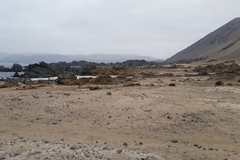 CHILE: Marine sediments and shells found at high altitudes in the arid Atacama Desert may have been deposited there as a result of the most powerful known earthquake in human history. Evidence suggests that a magnitude 9.5 seismic event struck northern Chile around 3,800 years ago, spawning a 60-foot-high tsunami that devastated the coast and wreaked havoc as far away as New Zealand. It’s thought that the pervasive memory of the catastrophic experience prompted local hunter-gatherer communities to withdraw from coastal settlements for more than a millennium.
CHILE: Marine sediments and shells found at high altitudes in the arid Atacama Desert may have been deposited there as a result of the most powerful known earthquake in human history. Evidence suggests that a magnitude 9.5 seismic event struck northern Chile around 3,800 years ago, spawning a 60-foot-high tsunami that devastated the coast and wreaked havoc as far away as New Zealand. It’s thought that the pervasive memory of the catastrophic experience prompted local hunter-gatherer communities to withdraw from coastal settlements for more than a millennium. -
 GREENLAND: Beginning in A.D. 985, Norse Vikings established a string of settlements in Greenland that thrived for around 400 years. Supported by animal husbandry, the population peaked at around 2,000 before people abruptly abandoned the island in the early 15th century. Experts had believed that a rapid drop in temperature drove the settlers out, but recent sediment analysis from a lakebed near one of their farmsteads indicated that the temperature actually remained steady. Instead, conditions suddenly became much drier, curtailing the growth of grass, which was vital for the survival of livestock.
GREENLAND: Beginning in A.D. 985, Norse Vikings established a string of settlements in Greenland that thrived for around 400 years. Supported by animal husbandry, the population peaked at around 2,000 before people abruptly abandoned the island in the early 15th century. Experts had believed that a rapid drop in temperature drove the settlers out, but recent sediment analysis from a lakebed near one of their farmsteads indicated that the temperature actually remained steady. Instead, conditions suddenly became much drier, curtailing the growth of grass, which was vital for the survival of livestock. -
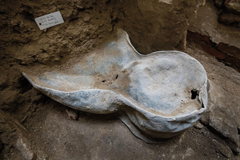 FRANCE: Workers restoring Paris’ Notre Dame Cathedral discovered a trove of architectural elements and sculptures hidden beneath the building’s floor that belonged to original sections of its 13th-century interior. They also unearthed several burials, including an unusual lead sarcophagus that likely holds the remains of a 14th-century church dignitary. The coffin was probed with a small camera that revealed that the deceased’s head rests on a well-preserved pillow made of leaves. This was a common practice in the burial of high-ranking medieval religious officials.
FRANCE: Workers restoring Paris’ Notre Dame Cathedral discovered a trove of architectural elements and sculptures hidden beneath the building’s floor that belonged to original sections of its 13th-century interior. They also unearthed several burials, including an unusual lead sarcophagus that likely holds the remains of a 14th-century church dignitary. The coffin was probed with a small camera that revealed that the deceased’s head rests on a well-preserved pillow made of leaves. This was a common practice in the burial of high-ranking medieval religious officials. -
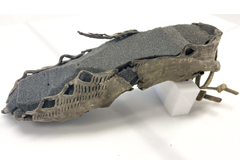 NORWAY: A traveler hiking through a high mountain pass in Oppland County 1,700 years ago seems to have cast off a shoe in frustration. The well-preserved Roman-style sandal emerged when ice and snow temporarily receded at Horse Ice Patch. The shoe’s flimsy open design was unsuitable for the rugged, snowy terrain 6,500 feet above sea level, and its owner likely discarded the shoe when it became worn and badly damaged.
NORWAY: A traveler hiking through a high mountain pass in Oppland County 1,700 years ago seems to have cast off a shoe in frustration. The well-preserved Roman-style sandal emerged when ice and snow temporarily receded at Horse Ice Patch. The shoe’s flimsy open design was unsuitable for the rugged, snowy terrain 6,500 feet above sea level, and its owner likely discarded the shoe when it became worn and badly damaged. -
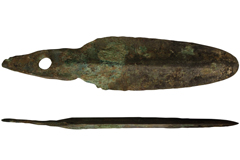 ITALY: Scholars once believed that a type of copper-alloy dagger commonly found in burials across Bronze Age Europe was ceremonial rather than functional. It was thought that these blades were included in graves to symbolize the warrior status of the dead. However, a new study employing cutting-edge technology detected the presence of muscle fibers and collagen from animal bone on daggers found in the village of Pragatto. This suggests that the knives were used to butcher and process animal carcasses and were not solely symbolic.
ITALY: Scholars once believed that a type of copper-alloy dagger commonly found in burials across Bronze Age Europe was ceremonial rather than functional. It was thought that these blades were included in graves to symbolize the warrior status of the dead. However, a new study employing cutting-edge technology detected the presence of muscle fibers and collagen from animal bone on daggers found in the village of Pragatto. This suggests that the knives were used to butcher and process animal carcasses and were not solely symbolic. -
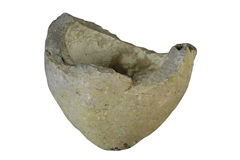 ISRAEL: Small spherical ceramic vessels, which were ubiquitous in the medieval Middle East, were used to hold a variety of liquids, including beer, wine, oil, and perfume. Occasionally, they could also be used as weapons. Residue analysis of an 11th- or 12th-century vessel from Jerusalem’s Armenian Garden indicates that it may have contained an explosive substance. It’s possible this small jar was converted into a type of hand grenade to be hurled at the nearby Crusader castle.
ISRAEL: Small spherical ceramic vessels, which were ubiquitous in the medieval Middle East, were used to hold a variety of liquids, including beer, wine, oil, and perfume. Occasionally, they could also be used as weapons. Residue analysis of an 11th- or 12th-century vessel from Jerusalem’s Armenian Garden indicates that it may have contained an explosive substance. It’s possible this small jar was converted into a type of hand grenade to be hurled at the nearby Crusader castle. -
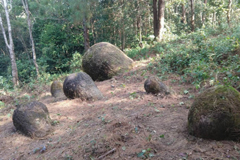 INDIA: Researchers conducting an archaeological survey in the state of Assam chanced upon 65 giant stone jars spread across 4 sites. The mysterious sandstone vessels vary in shape and size, with some reaching a height of 10 feet. The jars are similar to examples previously found in Laos and Indonesia, but researchers are unsure who carved them, much less when or why they were made. Although the vessels were found to be empty, they may have been used for burials as long ago as 400 B.C.
INDIA: Researchers conducting an archaeological survey in the state of Assam chanced upon 65 giant stone jars spread across 4 sites. The mysterious sandstone vessels vary in shape and size, with some reaching a height of 10 feet. The jars are similar to examples previously found in Laos and Indonesia, but researchers are unsure who carved them, much less when or why they were made. Although the vessels were found to be empty, they may have been used for burials as long ago as 400 B.C. -
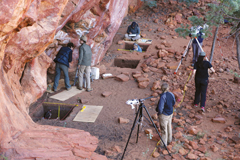 AUSTRALIA: Golden wattle, a type of acacia tree, is an important symbol of modern Australia and serves as its national flower. However, its roots run much deeper among the continent’s original inhabitants. Charcoal remains from Karnatukul cave shelter in the Carnarvon Range show that the hardy tree was an important resource for the Aboriginal Martu people, especially as a source of fuel. The 50,000-year-old cave site is the oldest known inhabited site in the Western Desert and contains the area’s earliest known use of firewood.
AUSTRALIA: Golden wattle, a type of acacia tree, is an important symbol of modern Australia and serves as its national flower. However, its roots run much deeper among the continent’s original inhabitants. Charcoal remains from Karnatukul cave shelter in the Carnarvon Range show that the hardy tree was an important resource for the Aboriginal Martu people, especially as a source of fuel. The 50,000-year-old cave site is the oldest known inhabited site in the Western Desert and contains the area’s earliest known use of firewood.
Advertisement
IN THIS ISSUE
Digs & Discoveries
Save the Dates
Spice Hunters
Suspicious Silver
A Civil War Bomb
The Great Maize Migration
Mummy Makers
Dignity of the Dead
Sailing in Sumer
Speak, Memories
The Maya Count Begins
Hail to the Chief
Made in China
Off the Grid
Around the World
Notre Dame’s dignitaries, Bronze Age daggers, the world’s biggest quake, a lost snowshoe, and 50,000-year-old Australians
Artifact
A portable connection
Advertisement

Recent Issues
-
 May/June 2024
May/June 2024
-
 March/April 2024
March/April 2024
-
 January/February 2024
January/February 2024
-
 November/December 2023
November/December 2023
-
 September/October 2023
September/October 2023
-
 July/August 2023
July/August 2023
-
 May/June 2023
May/June 2023
-
 March/April 2023
March/April 2023
-
 January/February 2023
January/February 2023
-
 November/December 2022
November/December 2022
-
 September/October 2022
September/October 2022
-
 July/August 2022
July/August 2022
-
 May/June 2022
May/June 2022
-
 March/April 2022
March/April 2022
-
 January/February 2022
January/February 2022
-
 November/December 2021
November/December 2021
-
 September/October 2021
September/October 2021
-
 July/August 2021
July/August 2021
-
 May/June 2021
May/June 2021
-
 March/April 2021
March/April 2021
-
 January/February 2021
January/February 2021
-
 November/December 2020
November/December 2020
-
 September/October 2020
September/October 2020
-
 July/August 2020
July/August 2020
-
 May/June 2020
May/June 2020
-
 March/April 2020
March/April 2020
-
 January/February 2020
January/February 2020
-
 November/December 2019
November/December 2019
-
 September/October 2019
September/October 2019
-
 July/August 2019
July/August 2019
-
 May/June 2019
May/June 2019
-
 March/April 2019
March/April 2019
-
 January/February 2019
January/February 2019
-
 November/December 2018
November/December 2018
-
 September/October 2018
September/October 2018
-
 July/August 2018
July/August 2018
-
 May/June 2018
May/June 2018
-
 March/April 2018
March/April 2018
-
 January/February 2018
January/February 2018
-
 November/December 2017
November/December 2017
-
 September/October 2017
September/October 2017
-
 July/August 2017
July/August 2017
-
 May/June 2017
May/June 2017
-
 March/April 2017
March/April 2017
-
 January/February 2017
January/February 2017
-
 November/December 2016
November/December 2016
-
 September/October 2016
September/October 2016
-
 July/August 2016
July/August 2016
-
 May/June 2016
May/June 2016
-
 March/April 2016
March/April 2016
-
 January/February 2016
January/February 2016
-
 November/December 2015
November/December 2015
-
 September/October 2015
September/October 2015
-
 July/August 2015
July/August 2015
-
 May/June 2015
May/June 2015
-
 March/April 2015
March/April 2015
-
 January/February 2015
January/February 2015
-
 November/December 2014
November/December 2014
-
 September/October 2014
September/October 2014
-
 July/August 2014
July/August 2014
-
 May/June 2014
May/June 2014
-
 March/April 2014
March/April 2014
-
 January/February 2014
January/February 2014
-
 November/December 2013
November/December 2013
-
 September/October 2013
September/October 2013
-
 July/August 2013
July/August 2013
-
 May/June 2013
May/June 2013
-
 March/April 2013
March/April 2013
-
 January/February 2013
January/February 2013
-
 November/December 2012
November/December 2012
-
 Sep/Oct 2012
Sep/Oct 2012
-
 September/October 2012
September/October 2012
-
 July/August 2012
July/August 2012
-
 May/June 2012
May/June 2012
-
 March/April 2012
March/April 2012
-
 January/February 2012
January/February 2012
-
 November/December 2011
November/December 2011
-
 September/October 2011
September/October 2011
-
 July/August 2011
July/August 2011
-
 May/June 2011
May/June 2011
-
 March/April 2011
March/April 2011
-
 January/February 2011
January/February 2011
Advertisement






